University Nursing Case Study: Patient Assessment, Actions, and Issues
VerifiedAdded on 2022/11/26
|16
|4040
|281
Case Study
AI Summary
This document presents three nursing case studies, each focusing on different patient scenarios and their associated medical conditions. The first case study analyzes a 64-year-old patient, William, with a history of heart failure, exploring the pathophysiology of sudden cardiac arrest, pulmonary edema, and myocardial infarction. It details appropriate nursing actions, such as oxygen administration and medication, and addresses ethical considerations related to patient care. The second case study involves Carol, a 59-year-old patient post-knee replacement, and examines the pathophysiology of hypovolemic shock, septic shock, and respiratory distress, detailing the rationale behind nursing interventions like fluid replacement and blood transfusions. It also highlights the professional issues arising from communication challenges with the patient's partner. The third case study focuses on Glenn, presenting with spontaneous pneumothorax, hypoxia, and pain. It outlines the pathophysiology of the condition, including tissue damage and air leakage, and recommends nursing actions such as medication for pain management and measures to address pneumothorax, while also discussing ethical dilemmas related to patient restlessness and requests.
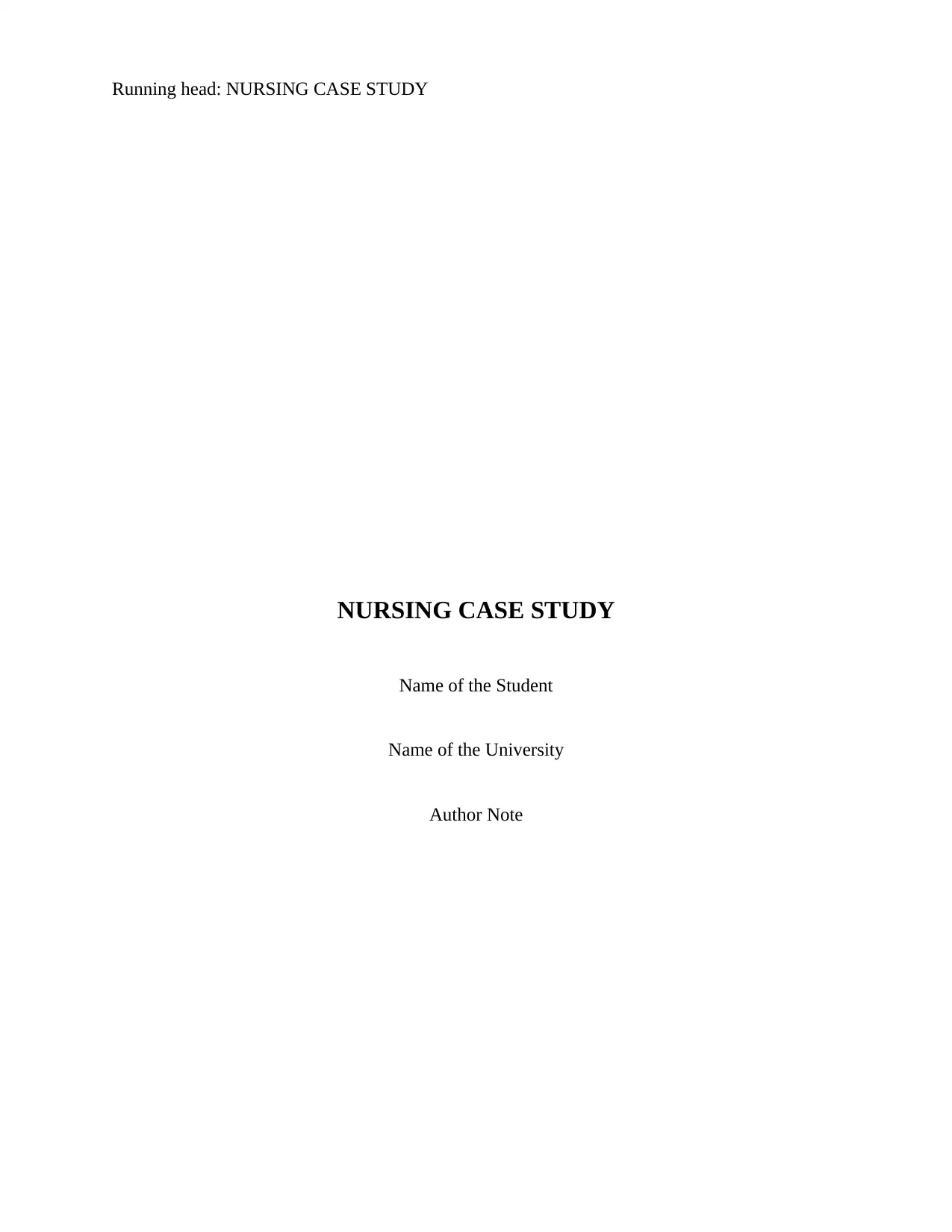
Running head: NURSING CASE STUDY
NURSING CASE STUDY
Name of the Student
Name of the University
Author Note
NURSING CASE STUDY
Name of the Student
Name of the University
Author Note
Paraphrase This Document
Need a fresh take? Get an instant paraphrase of this document with our AI Paraphraser
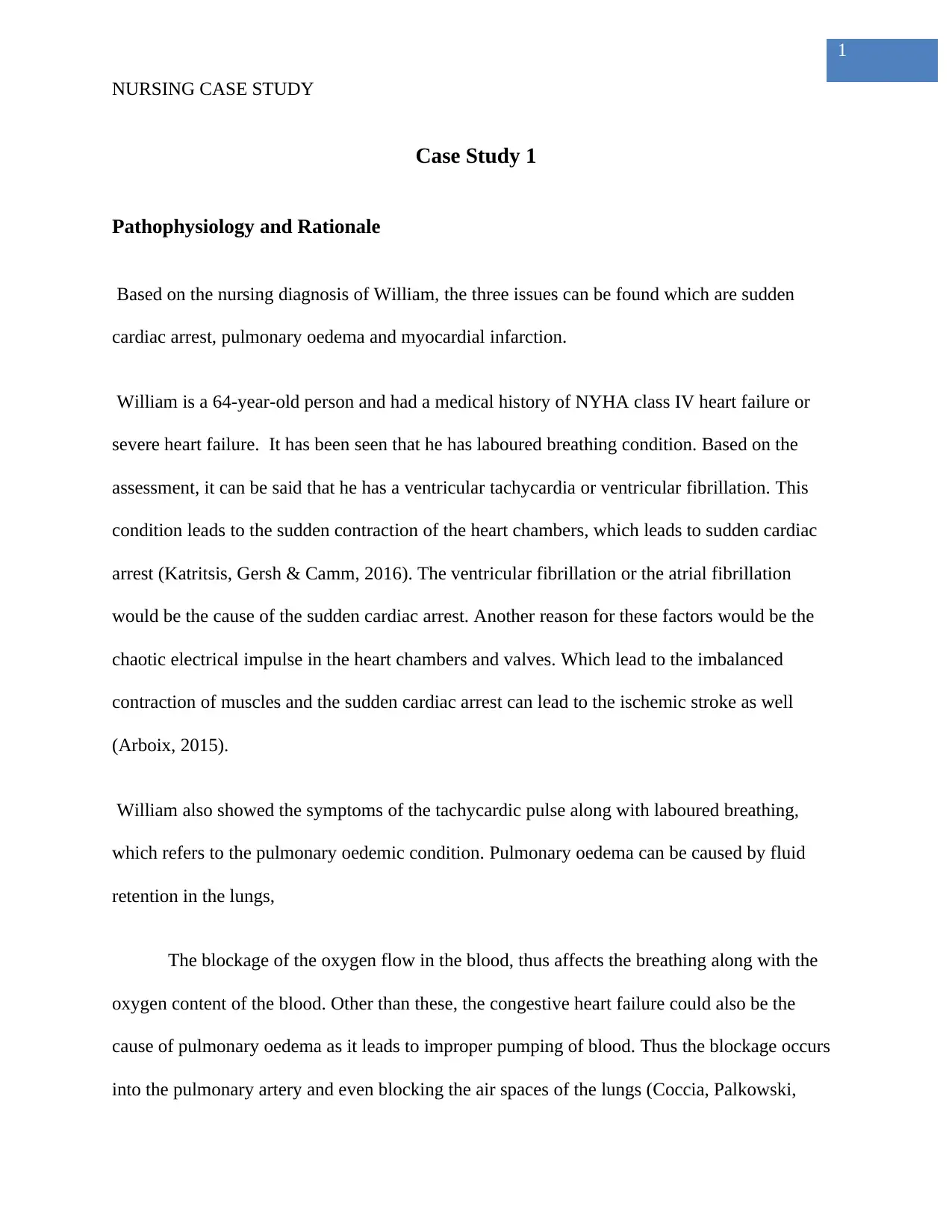
1
NURSING CASE STUDY
Case Study 1
Pathophysiology and Rationale
Based on the nursing diagnosis of William, the three issues can be found which are sudden
cardiac arrest, pulmonary oedema and myocardial infarction.
William is a 64-year-old person and had a medical history of NYHA class IV heart failure or
severe heart failure. It has been seen that he has laboured breathing condition. Based on the
assessment, it can be said that he has a ventricular tachycardia or ventricular fibrillation. This
condition leads to the sudden contraction of the heart chambers, which leads to sudden cardiac
arrest (Katritsis, Gersh & Camm, 2016). The ventricular fibrillation or the atrial fibrillation
would be the cause of the sudden cardiac arrest. Another reason for these factors would be the
chaotic electrical impulse in the heart chambers and valves. Which lead to the imbalanced
contraction of muscles and the sudden cardiac arrest can lead to the ischemic stroke as well
(Arboix, 2015).
William also showed the symptoms of the tachycardic pulse along with laboured breathing,
which refers to the pulmonary oedemic condition. Pulmonary oedema can be caused by fluid
retention in the lungs,
The blockage of the oxygen flow in the blood, thus affects the breathing along with the
oxygen content of the blood. Other than these, the congestive heart failure could also be the
cause of pulmonary oedema as it leads to improper pumping of blood. Thus the blockage occurs
into the pulmonary artery and even blocking the air spaces of the lungs (Coccia, Palkowski,
NURSING CASE STUDY
Case Study 1
Pathophysiology and Rationale
Based on the nursing diagnosis of William, the three issues can be found which are sudden
cardiac arrest, pulmonary oedema and myocardial infarction.
William is a 64-year-old person and had a medical history of NYHA class IV heart failure or
severe heart failure. It has been seen that he has laboured breathing condition. Based on the
assessment, it can be said that he has a ventricular tachycardia or ventricular fibrillation. This
condition leads to the sudden contraction of the heart chambers, which leads to sudden cardiac
arrest (Katritsis, Gersh & Camm, 2016). The ventricular fibrillation or the atrial fibrillation
would be the cause of the sudden cardiac arrest. Another reason for these factors would be the
chaotic electrical impulse in the heart chambers and valves. Which lead to the imbalanced
contraction of muscles and the sudden cardiac arrest can lead to the ischemic stroke as well
(Arboix, 2015).
William also showed the symptoms of the tachycardic pulse along with laboured breathing,
which refers to the pulmonary oedemic condition. Pulmonary oedema can be caused by fluid
retention in the lungs,
The blockage of the oxygen flow in the blood, thus affects the breathing along with the
oxygen content of the blood. Other than these, the congestive heart failure could also be the
cause of pulmonary oedema as it leads to improper pumping of blood. Thus the blockage occurs
into the pulmonary artery and even blocking the air spaces of the lungs (Coccia, Palkowski,
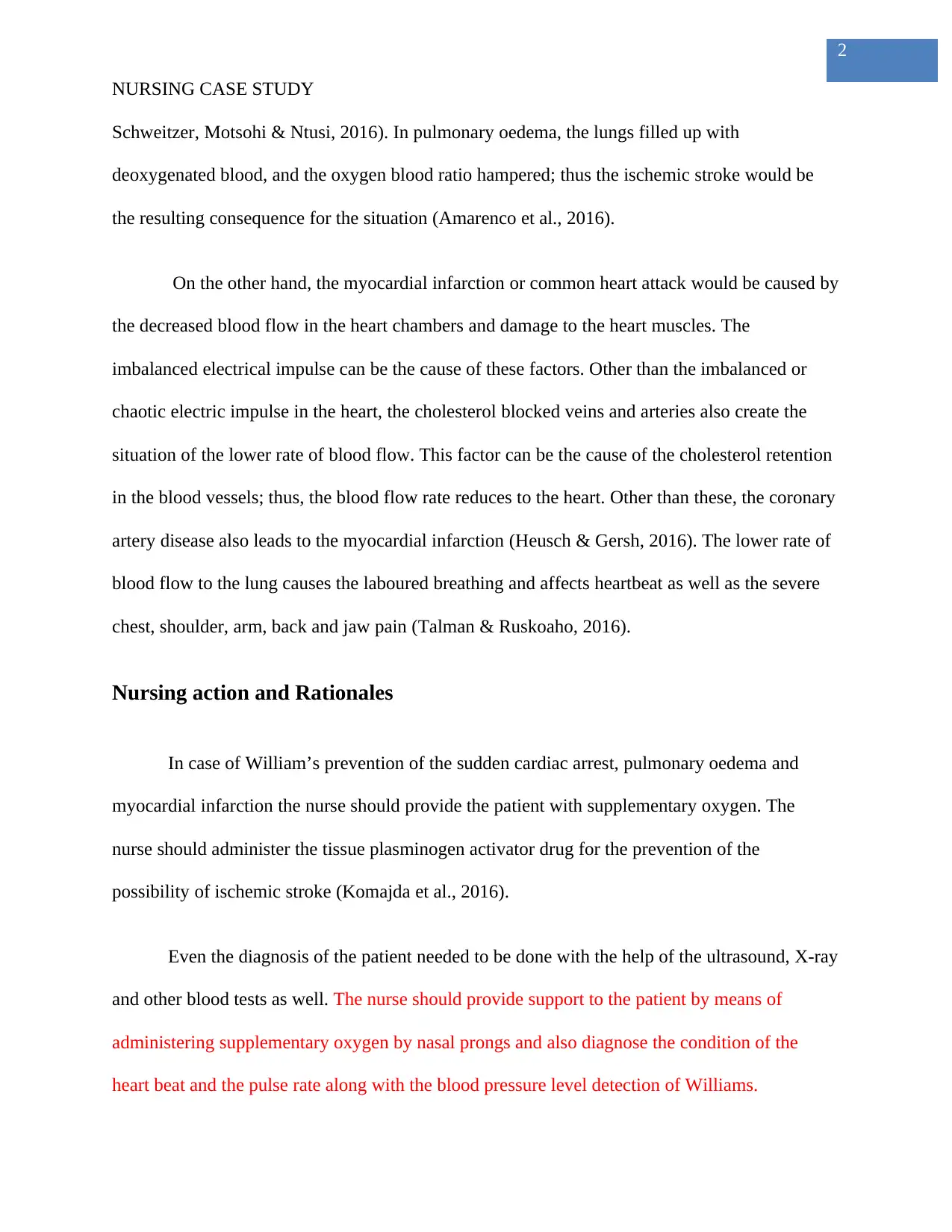
2
NURSING CASE STUDY
Schweitzer, Motsohi & Ntusi, 2016). In pulmonary oedema, the lungs filled up with
deoxygenated blood, and the oxygen blood ratio hampered; thus the ischemic stroke would be
the resulting consequence for the situation (Amarenco et al., 2016).
On the other hand, the myocardial infarction or common heart attack would be caused by
the decreased blood flow in the heart chambers and damage to the heart muscles. The
imbalanced electrical impulse can be the cause of these factors. Other than the imbalanced or
chaotic electric impulse in the heart, the cholesterol blocked veins and arteries also create the
situation of the lower rate of blood flow. This factor can be the cause of the cholesterol retention
in the blood vessels; thus, the blood flow rate reduces to the heart. Other than these, the coronary
artery disease also leads to the myocardial infarction (Heusch & Gersh, 2016). The lower rate of
blood flow to the lung causes the laboured breathing and affects heartbeat as well as the severe
chest, shoulder, arm, back and jaw pain (Talman & Ruskoaho, 2016).
Nursing action and Rationales
In case of William’s prevention of the sudden cardiac arrest, pulmonary oedema and
myocardial infarction the nurse should provide the patient with supplementary oxygen. The
nurse should administer the tissue plasminogen activator drug for the prevention of the
possibility of ischemic stroke (Komajda et al., 2016).
Even the diagnosis of the patient needed to be done with the help of the ultrasound, X-ray
and other blood tests as well. The nurse should provide support to the patient by means of
administering supplementary oxygen by nasal prongs and also diagnose the condition of the
heart beat and the pulse rate along with the blood pressure level detection of Williams.
NURSING CASE STUDY
Schweitzer, Motsohi & Ntusi, 2016). In pulmonary oedema, the lungs filled up with
deoxygenated blood, and the oxygen blood ratio hampered; thus the ischemic stroke would be
the resulting consequence for the situation (Amarenco et al., 2016).
On the other hand, the myocardial infarction or common heart attack would be caused by
the decreased blood flow in the heart chambers and damage to the heart muscles. The
imbalanced electrical impulse can be the cause of these factors. Other than the imbalanced or
chaotic electric impulse in the heart, the cholesterol blocked veins and arteries also create the
situation of the lower rate of blood flow. This factor can be the cause of the cholesterol retention
in the blood vessels; thus, the blood flow rate reduces to the heart. Other than these, the coronary
artery disease also leads to the myocardial infarction (Heusch & Gersh, 2016). The lower rate of
blood flow to the lung causes the laboured breathing and affects heartbeat as well as the severe
chest, shoulder, arm, back and jaw pain (Talman & Ruskoaho, 2016).
Nursing action and Rationales
In case of William’s prevention of the sudden cardiac arrest, pulmonary oedema and
myocardial infarction the nurse should provide the patient with supplementary oxygen. The
nurse should administer the tissue plasminogen activator drug for the prevention of the
possibility of ischemic stroke (Komajda et al., 2016).
Even the diagnosis of the patient needed to be done with the help of the ultrasound, X-ray
and other blood tests as well. The nurse should provide support to the patient by means of
administering supplementary oxygen by nasal prongs and also diagnose the condition of the
heart beat and the pulse rate along with the blood pressure level detection of Williams.
⊘ This is a preview!⊘
Do you want full access?
Subscribe today to unlock all pages.

Trusted by 1+ million students worldwide
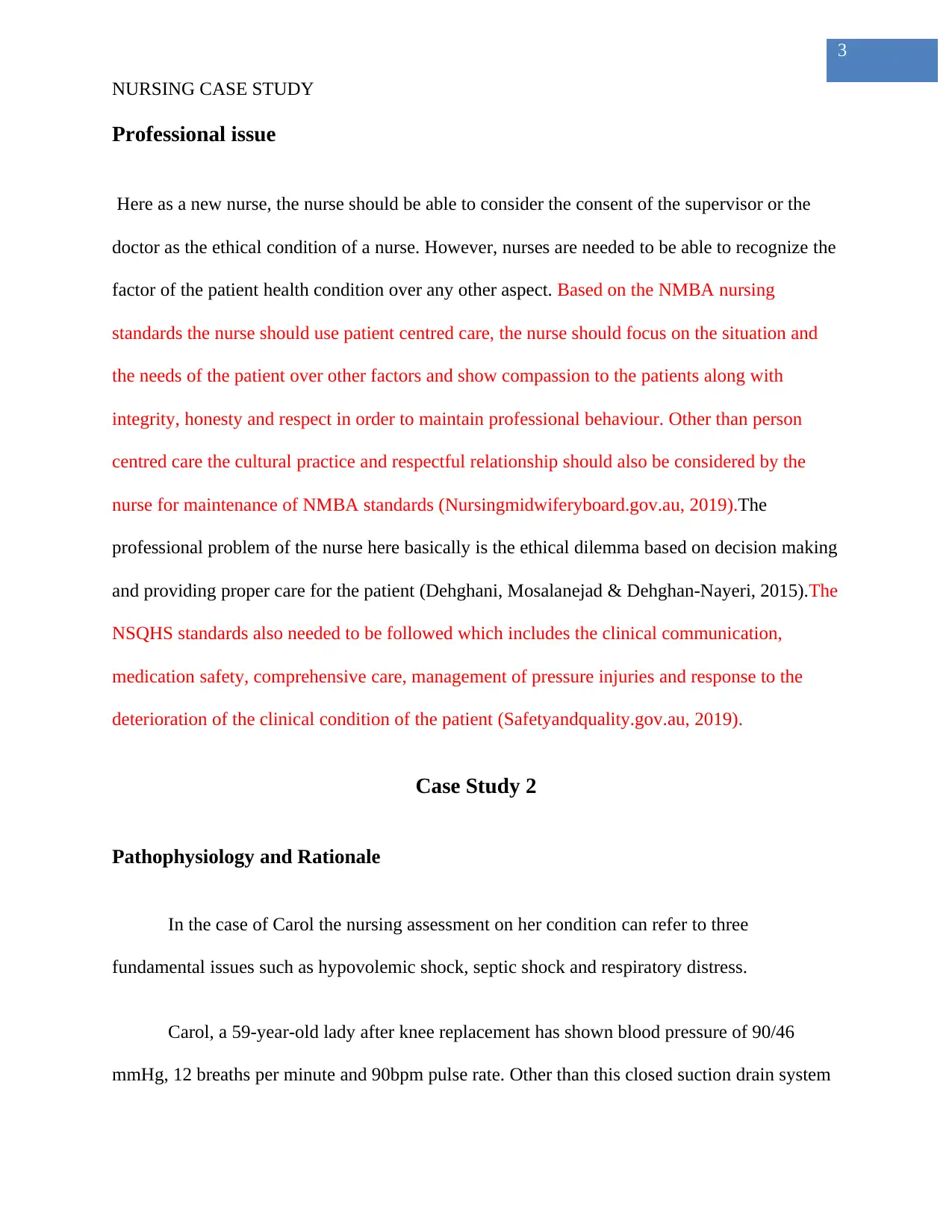
3
NURSING CASE STUDY
Professional issue
Here as a new nurse, the nurse should be able to consider the consent of the supervisor or the
doctor as the ethical condition of a nurse. However, nurses are needed to be able to recognize the
factor of the patient health condition over any other aspect. Based on the NMBA nursing
standards the nurse should use patient centred care, the nurse should focus on the situation and
the needs of the patient over other factors and show compassion to the patients along with
integrity, honesty and respect in order to maintain professional behaviour. Other than person
centred care the cultural practice and respectful relationship should also be considered by the
nurse for maintenance of NMBA standards (Nursingmidwiferyboard.gov.au, 2019).The
professional problem of the nurse here basically is the ethical dilemma based on decision making
and providing proper care for the patient (Dehghani, Mosalanejad & Dehghan-Nayeri, 2015).The
NSQHS standards also needed to be followed which includes the clinical communication,
medication safety, comprehensive care, management of pressure injuries and response to the
deterioration of the clinical condition of the patient (Safetyandquality.gov.au, 2019).
Case Study 2
Pathophysiology and Rationale
In the case of Carol the nursing assessment on her condition can refer to three
fundamental issues such as hypovolemic shock, septic shock and respiratory distress.
Carol, a 59-year-old lady after knee replacement has shown blood pressure of 90/46
mmHg, 12 breaths per minute and 90bpm pulse rate. Other than this closed suction drain system
NURSING CASE STUDY
Professional issue
Here as a new nurse, the nurse should be able to consider the consent of the supervisor or the
doctor as the ethical condition of a nurse. However, nurses are needed to be able to recognize the
factor of the patient health condition over any other aspect. Based on the NMBA nursing
standards the nurse should use patient centred care, the nurse should focus on the situation and
the needs of the patient over other factors and show compassion to the patients along with
integrity, honesty and respect in order to maintain professional behaviour. Other than person
centred care the cultural practice and respectful relationship should also be considered by the
nurse for maintenance of NMBA standards (Nursingmidwiferyboard.gov.au, 2019).The
professional problem of the nurse here basically is the ethical dilemma based on decision making
and providing proper care for the patient (Dehghani, Mosalanejad & Dehghan-Nayeri, 2015).The
NSQHS standards also needed to be followed which includes the clinical communication,
medication safety, comprehensive care, management of pressure injuries and response to the
deterioration of the clinical condition of the patient (Safetyandquality.gov.au, 2019).
Case Study 2
Pathophysiology and Rationale
In the case of Carol the nursing assessment on her condition can refer to three
fundamental issues such as hypovolemic shock, septic shock and respiratory distress.
Carol, a 59-year-old lady after knee replacement has shown blood pressure of 90/46
mmHg, 12 breaths per minute and 90bpm pulse rate. Other than this closed suction drain system
Paraphrase This Document
Need a fresh take? Get an instant paraphrase of this document with our AI Paraphraser
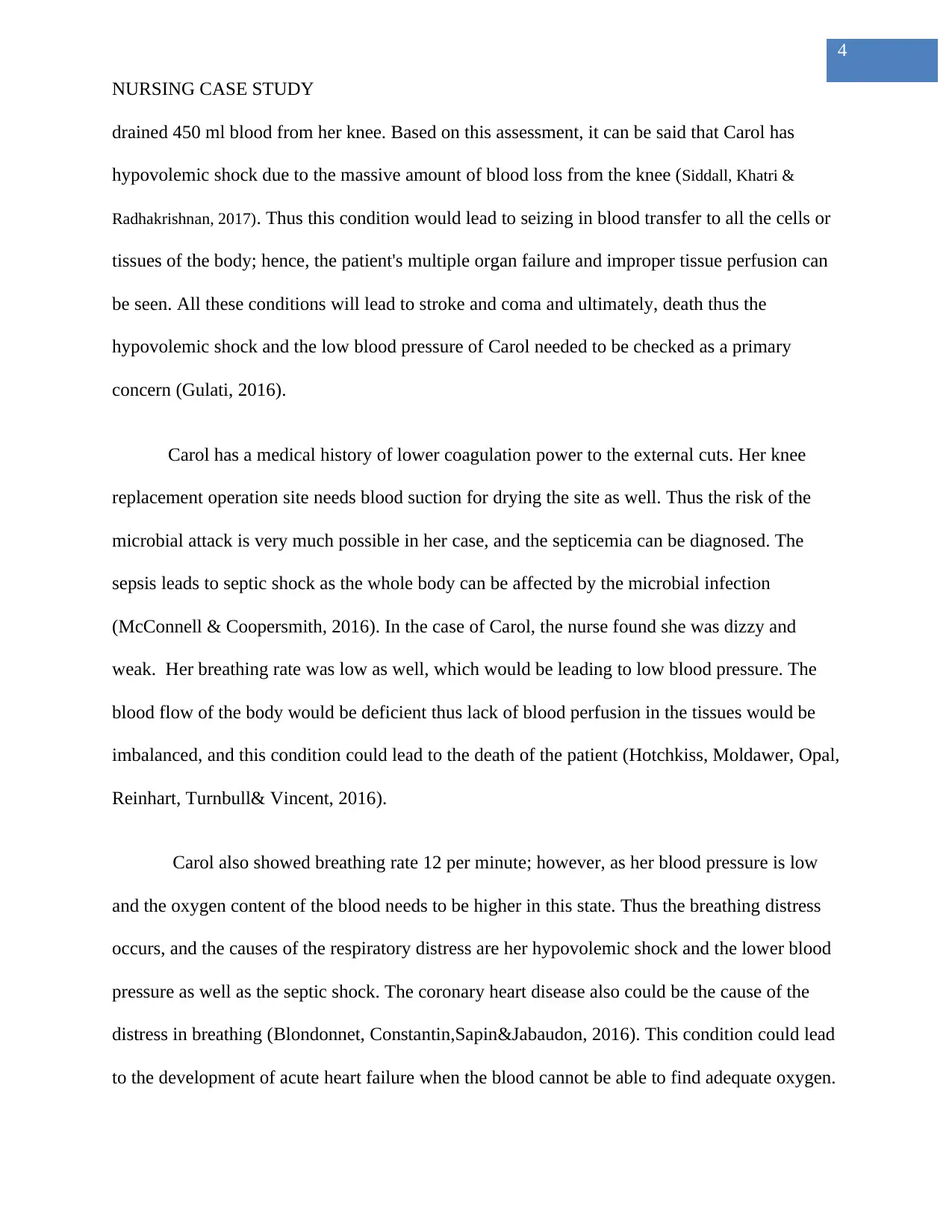
4
NURSING CASE STUDY
drained 450 ml blood from her knee. Based on this assessment, it can be said that Carol has
hypovolemic shock due to the massive amount of blood loss from the knee (Siddall, Khatri &
Radhakrishnan, 2017). Thus this condition would lead to seizing in blood transfer to all the cells or
tissues of the body; hence, the patient's multiple organ failure and improper tissue perfusion can
be seen. All these conditions will lead to stroke and coma and ultimately, death thus the
hypovolemic shock and the low blood pressure of Carol needed to be checked as a primary
concern (Gulati, 2016).
Carol has a medical history of lower coagulation power to the external cuts. Her knee
replacement operation site needs blood suction for drying the site as well. Thus the risk of the
microbial attack is very much possible in her case, and the septicemia can be diagnosed. The
sepsis leads to septic shock as the whole body can be affected by the microbial infection
(McConnell & Coopersmith, 2016). In the case of Carol, the nurse found she was dizzy and
weak. Her breathing rate was low as well, which would be leading to low blood pressure. The
blood flow of the body would be deficient thus lack of blood perfusion in the tissues would be
imbalanced, and this condition could lead to the death of the patient (Hotchkiss, Moldawer, Opal,
Reinhart, Turnbull& Vincent, 2016).
Carol also showed breathing rate 12 per minute; however, as her blood pressure is low
and the oxygen content of the blood needs to be higher in this state. Thus the breathing distress
occurs, and the causes of the respiratory distress are her hypovolemic shock and the lower blood
pressure as well as the septic shock. The coronary heart disease also could be the cause of the
distress in breathing (Blondonnet, Constantin,Sapin&Jabaudon, 2016). This condition could lead
to the development of acute heart failure when the blood cannot be able to find adequate oxygen.
NURSING CASE STUDY
drained 450 ml blood from her knee. Based on this assessment, it can be said that Carol has
hypovolemic shock due to the massive amount of blood loss from the knee (Siddall, Khatri &
Radhakrishnan, 2017). Thus this condition would lead to seizing in blood transfer to all the cells or
tissues of the body; hence, the patient's multiple organ failure and improper tissue perfusion can
be seen. All these conditions will lead to stroke and coma and ultimately, death thus the
hypovolemic shock and the low blood pressure of Carol needed to be checked as a primary
concern (Gulati, 2016).
Carol has a medical history of lower coagulation power to the external cuts. Her knee
replacement operation site needs blood suction for drying the site as well. Thus the risk of the
microbial attack is very much possible in her case, and the septicemia can be diagnosed. The
sepsis leads to septic shock as the whole body can be affected by the microbial infection
(McConnell & Coopersmith, 2016). In the case of Carol, the nurse found she was dizzy and
weak. Her breathing rate was low as well, which would be leading to low blood pressure. The
blood flow of the body would be deficient thus lack of blood perfusion in the tissues would be
imbalanced, and this condition could lead to the death of the patient (Hotchkiss, Moldawer, Opal,
Reinhart, Turnbull& Vincent, 2016).
Carol also showed breathing rate 12 per minute; however, as her blood pressure is low
and the oxygen content of the blood needs to be higher in this state. Thus the breathing distress
occurs, and the causes of the respiratory distress are her hypovolemic shock and the lower blood
pressure as well as the septic shock. The coronary heart disease also could be the cause of the
distress in breathing (Blondonnet, Constantin,Sapin&Jabaudon, 2016). This condition could lead
to the development of acute heart failure when the blood cannot be able to find adequate oxygen.
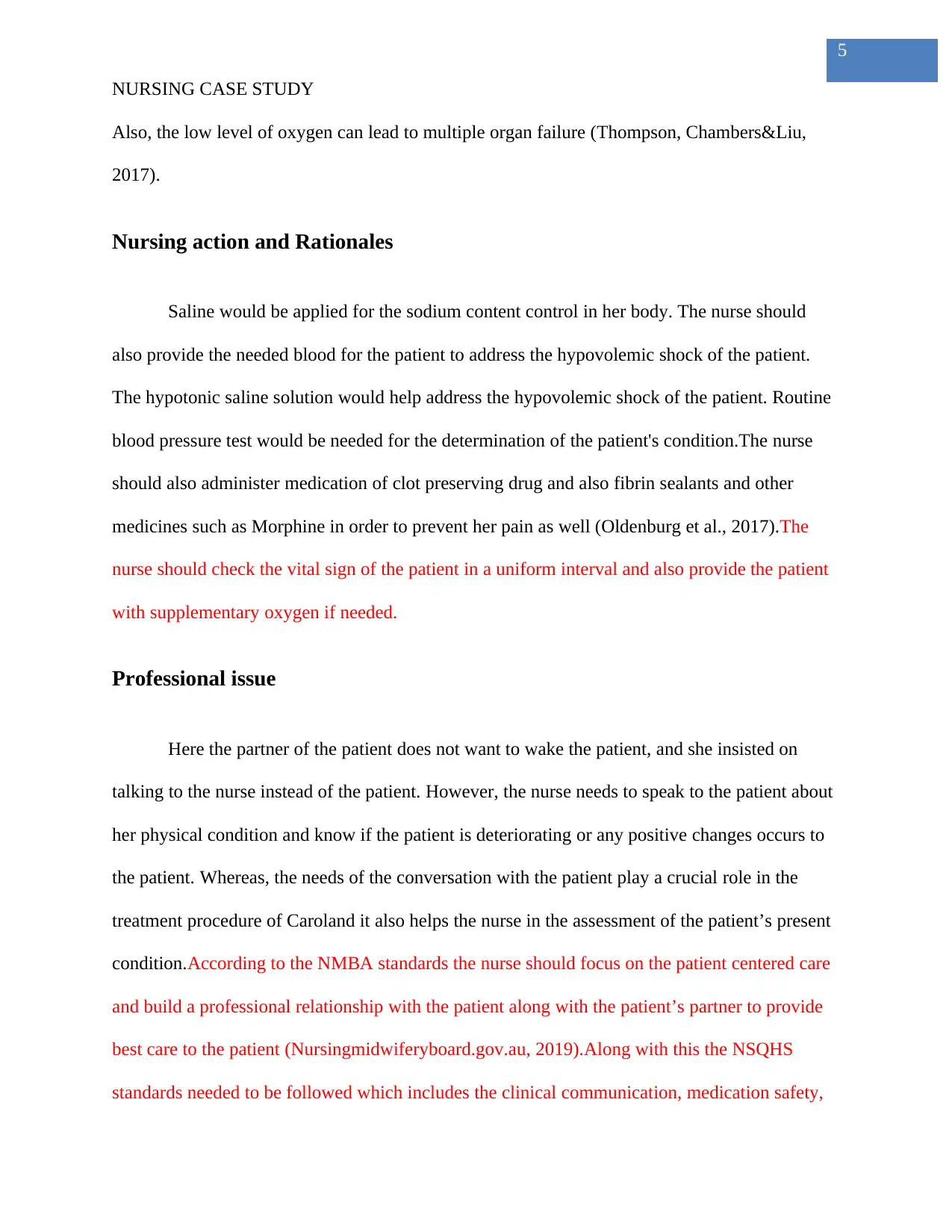
5
NURSING CASE STUDY
Also, the low level of oxygen can lead to multiple organ failure (Thompson, Chambers&Liu,
2017).
Nursing action and Rationales
Saline would be applied for the sodium content control in her body. The nurse should
also provide the needed blood for the patient to address the hypovolemic shock of the patient.
The hypotonic saline solution would help address the hypovolemic shock of the patient. Routine
blood pressure test would be needed for the determination of the patient's condition.The nurse
should also administer medication of clot preserving drug and also fibrin sealants and other
medicines such as Morphine in order to prevent her pain as well (Oldenburg et al., 2017).The
nurse should check the vital sign of the patient in a uniform interval and also provide the patient
with supplementary oxygen if needed.
Professional issue
Here the partner of the patient does not want to wake the patient, and she insisted on
talking to the nurse instead of the patient. However, the nurse needs to speak to the patient about
her physical condition and know if the patient is deteriorating or any positive changes occurs to
the patient. Whereas, the needs of the conversation with the patient play a crucial role in the
treatment procedure of Caroland it also helps the nurse in the assessment of the patient’s present
condition.According to the NMBA standards the nurse should focus on the patient centered care
and build a professional relationship with the patient along with the patient’s partner to provide
best care to the patient (Nursingmidwiferyboard.gov.au, 2019).Along with this the NSQHS
standards needed to be followed which includes the clinical communication, medication safety,
NURSING CASE STUDY
Also, the low level of oxygen can lead to multiple organ failure (Thompson, Chambers&Liu,
2017).
Nursing action and Rationales
Saline would be applied for the sodium content control in her body. The nurse should
also provide the needed blood for the patient to address the hypovolemic shock of the patient.
The hypotonic saline solution would help address the hypovolemic shock of the patient. Routine
blood pressure test would be needed for the determination of the patient's condition.The nurse
should also administer medication of clot preserving drug and also fibrin sealants and other
medicines such as Morphine in order to prevent her pain as well (Oldenburg et al., 2017).The
nurse should check the vital sign of the patient in a uniform interval and also provide the patient
with supplementary oxygen if needed.
Professional issue
Here the partner of the patient does not want to wake the patient, and she insisted on
talking to the nurse instead of the patient. However, the nurse needs to speak to the patient about
her physical condition and know if the patient is deteriorating or any positive changes occurs to
the patient. Whereas, the needs of the conversation with the patient play a crucial role in the
treatment procedure of Caroland it also helps the nurse in the assessment of the patient’s present
condition.According to the NMBA standards the nurse should focus on the patient centered care
and build a professional relationship with the patient along with the patient’s partner to provide
best care to the patient (Nursingmidwiferyboard.gov.au, 2019).Along with this the NSQHS
standards needed to be followed which includes the clinical communication, medication safety,
⊘ This is a preview!⊘
Do you want full access?
Subscribe today to unlock all pages.

Trusted by 1+ million students worldwide
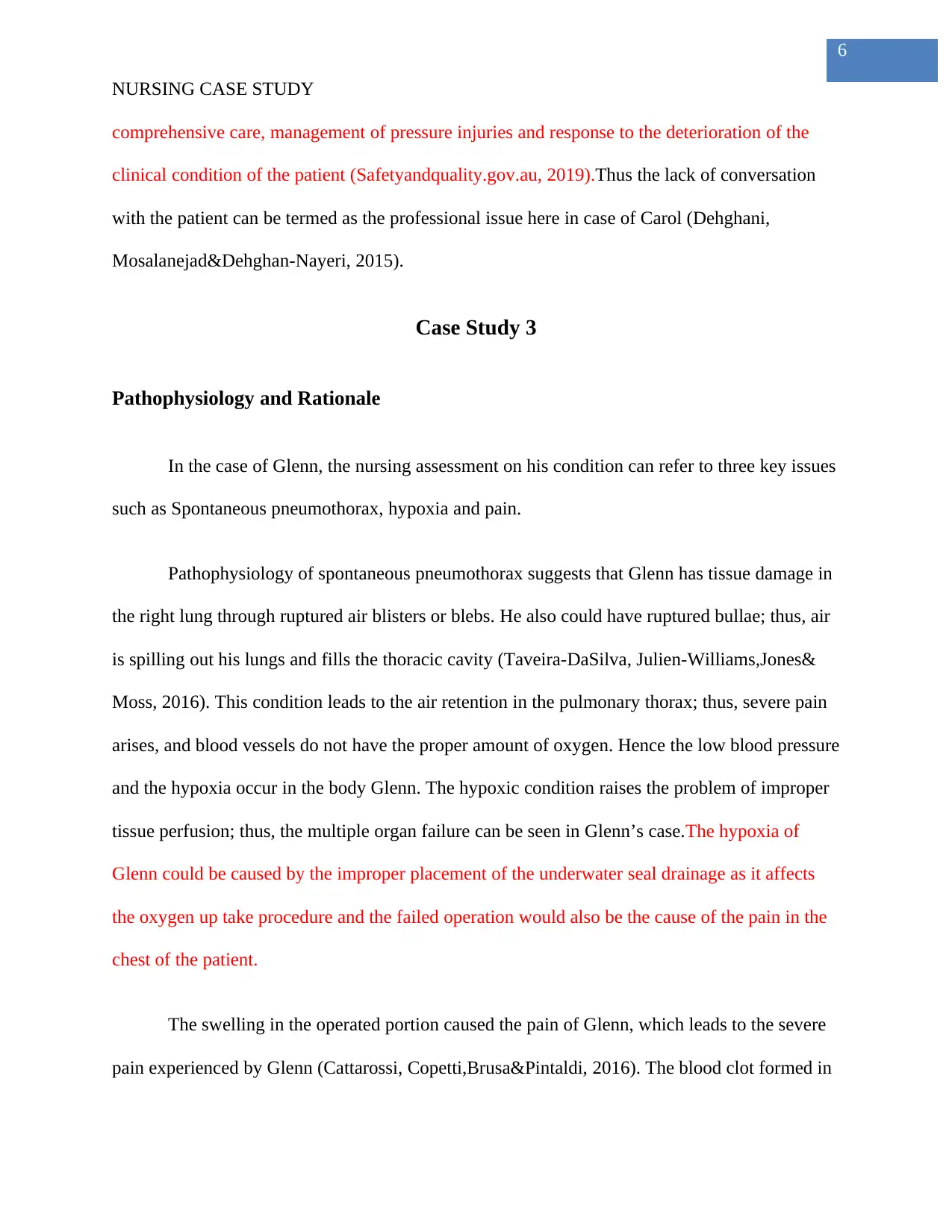
6
NURSING CASE STUDY
comprehensive care, management of pressure injuries and response to the deterioration of the
clinical condition of the patient (Safetyandquality.gov.au, 2019).Thus the lack of conversation
with the patient can be termed as the professional issue here in case of Carol (Dehghani,
Mosalanejad&Dehghan-Nayeri, 2015).
Case Study 3
Pathophysiology and Rationale
In the case of Glenn, the nursing assessment on his condition can refer to three key issues
such as Spontaneous pneumothorax, hypoxia and pain.
Pathophysiology of spontaneous pneumothorax suggests that Glenn has tissue damage in
the right lung through ruptured air blisters or blebs. He also could have ruptured bullae; thus, air
is spilling out his lungs and fills the thoracic cavity (Taveira-DaSilva, Julien-Williams,Jones&
Moss, 2016). This condition leads to the air retention in the pulmonary thorax; thus, severe pain
arises, and blood vessels do not have the proper amount of oxygen. Hence the low blood pressure
and the hypoxia occur in the body Glenn. The hypoxic condition raises the problem of improper
tissue perfusion; thus, the multiple organ failure can be seen in Glenn’s case.The hypoxia of
Glenn could be caused by the improper placement of the underwater seal drainage as it affects
the oxygen up take procedure and the failed operation would also be the cause of the pain in the
chest of the patient.
The swelling in the operated portion caused the pain of Glenn, which leads to the severe
pain experienced by Glenn (Cattarossi, Copetti,Brusa&Pintaldi, 2016). The blood clot formed in
NURSING CASE STUDY
comprehensive care, management of pressure injuries and response to the deterioration of the
clinical condition of the patient (Safetyandquality.gov.au, 2019).Thus the lack of conversation
with the patient can be termed as the professional issue here in case of Carol (Dehghani,
Mosalanejad&Dehghan-Nayeri, 2015).
Case Study 3
Pathophysiology and Rationale
In the case of Glenn, the nursing assessment on his condition can refer to three key issues
such as Spontaneous pneumothorax, hypoxia and pain.
Pathophysiology of spontaneous pneumothorax suggests that Glenn has tissue damage in
the right lung through ruptured air blisters or blebs. He also could have ruptured bullae; thus, air
is spilling out his lungs and fills the thoracic cavity (Taveira-DaSilva, Julien-Williams,Jones&
Moss, 2016). This condition leads to the air retention in the pulmonary thorax; thus, severe pain
arises, and blood vessels do not have the proper amount of oxygen. Hence the low blood pressure
and the hypoxia occur in the body Glenn. The hypoxic condition raises the problem of improper
tissue perfusion; thus, the multiple organ failure can be seen in Glenn’s case.The hypoxia of
Glenn could be caused by the improper placement of the underwater seal drainage as it affects
the oxygen up take procedure and the failed operation would also be the cause of the pain in the
chest of the patient.
The swelling in the operated portion caused the pain of Glenn, which leads to the severe
pain experienced by Glenn (Cattarossi, Copetti,Brusa&Pintaldi, 2016). The blood clot formed in
Paraphrase This Document
Need a fresh take? Get an instant paraphrase of this document with our AI Paraphraser
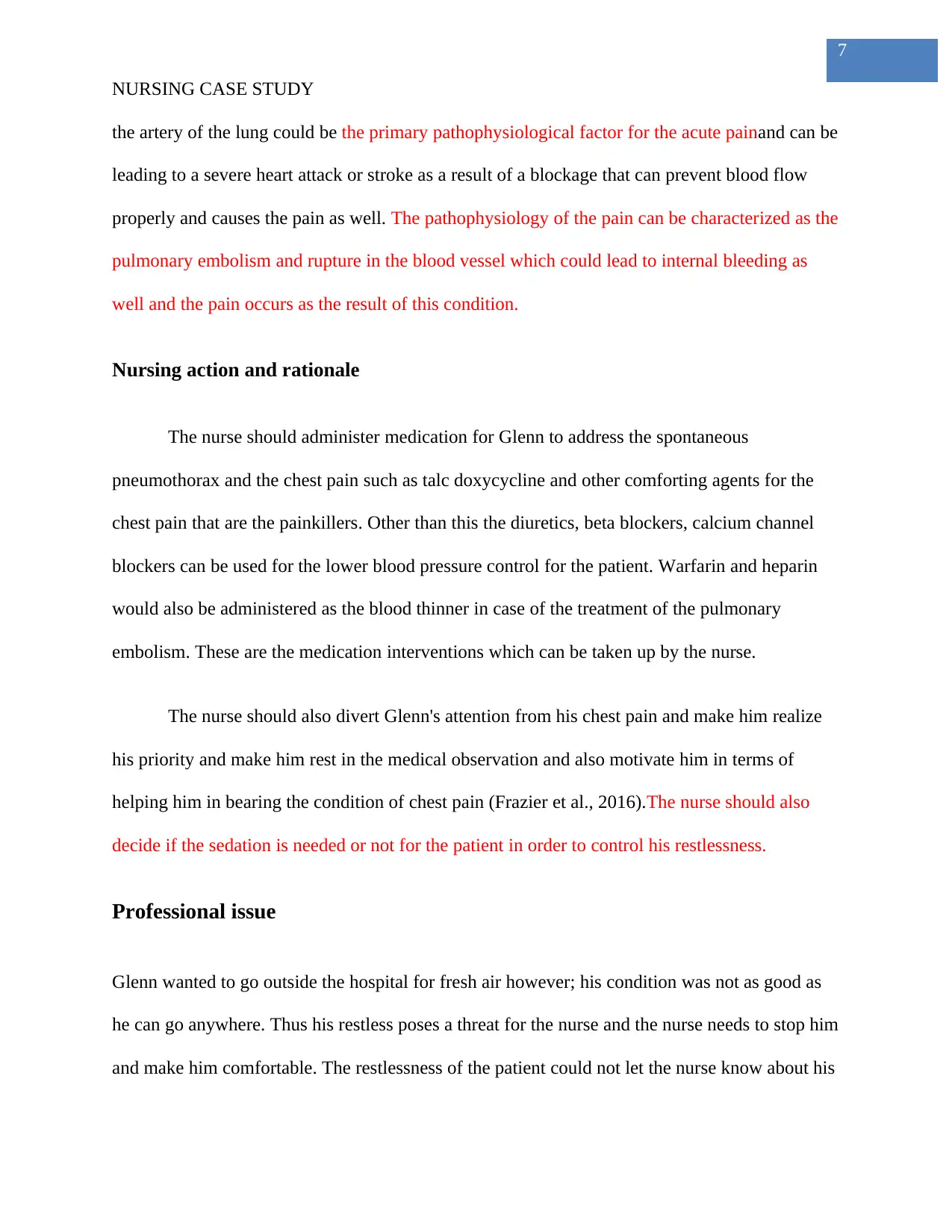
7
NURSING CASE STUDY
the artery of the lung could be the primary pathophysiological factor for the acute painand can be
leading to a severe heart attack or stroke as a result of a blockage that can prevent blood flow
properly and causes the pain as well. The pathophysiology of the pain can be characterized as the
pulmonary embolism and rupture in the blood vessel which could lead to internal bleeding as
well and the pain occurs as the result of this condition.
Nursing action and rationale
The nurse should administer medication for Glenn to address the spontaneous
pneumothorax and the chest pain such as talc doxycycline and other comforting agents for the
chest pain that are the painkillers. Other than this the diuretics, beta blockers, calcium channel
blockers can be used for the lower blood pressure control for the patient. Warfarin and heparin
would also be administered as the blood thinner in case of the treatment of the pulmonary
embolism. These are the medication interventions which can be taken up by the nurse.
The nurse should also divert Glenn's attention from his chest pain and make him realize
his priority and make him rest in the medical observation and also motivate him in terms of
helping him in bearing the condition of chest pain (Frazier et al., 2016).The nurse should also
decide if the sedation is needed or not for the patient in order to control his restlessness.
Professional issue
Glenn wanted to go outside the hospital for fresh air however; his condition was not as good as
he can go anywhere. Thus his restless poses a threat for the nurse and the nurse needs to stop him
and make him comfortable. The restlessness of the patient could not let the nurse know about his
NURSING CASE STUDY
the artery of the lung could be the primary pathophysiological factor for the acute painand can be
leading to a severe heart attack or stroke as a result of a blockage that can prevent blood flow
properly and causes the pain as well. The pathophysiology of the pain can be characterized as the
pulmonary embolism and rupture in the blood vessel which could lead to internal bleeding as
well and the pain occurs as the result of this condition.
Nursing action and rationale
The nurse should administer medication for Glenn to address the spontaneous
pneumothorax and the chest pain such as talc doxycycline and other comforting agents for the
chest pain that are the painkillers. Other than this the diuretics, beta blockers, calcium channel
blockers can be used for the lower blood pressure control for the patient. Warfarin and heparin
would also be administered as the blood thinner in case of the treatment of the pulmonary
embolism. These are the medication interventions which can be taken up by the nurse.
The nurse should also divert Glenn's attention from his chest pain and make him realize
his priority and make him rest in the medical observation and also motivate him in terms of
helping him in bearing the condition of chest pain (Frazier et al., 2016).The nurse should also
decide if the sedation is needed or not for the patient in order to control his restlessness.
Professional issue
Glenn wanted to go outside the hospital for fresh air however; his condition was not as good as
he can go anywhere. Thus his restless poses a threat for the nurse and the nurse needs to stop him
and make him comfortable. The restlessness of the patient could not let the nurse know about his
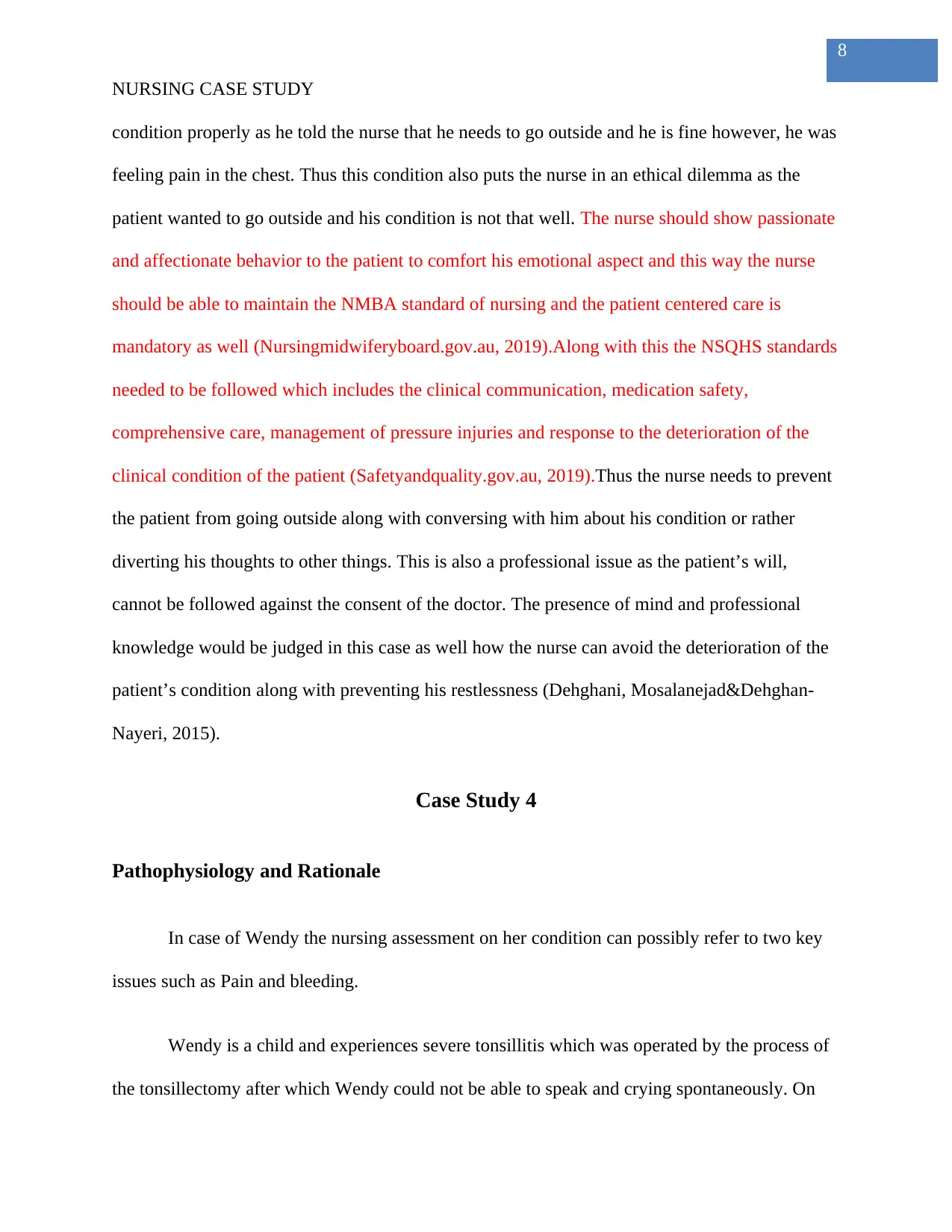
8
NURSING CASE STUDY
condition properly as he told the nurse that he needs to go outside and he is fine however, he was
feeling pain in the chest. Thus this condition also puts the nurse in an ethical dilemma as the
patient wanted to go outside and his condition is not that well. The nurse should show passionate
and affectionate behavior to the patient to comfort his emotional aspect and this way the nurse
should be able to maintain the NMBA standard of nursing and the patient centered care is
mandatory as well (Nursingmidwiferyboard.gov.au, 2019).Along with this the NSQHS standards
needed to be followed which includes the clinical communication, medication safety,
comprehensive care, management of pressure injuries and response to the deterioration of the
clinical condition of the patient (Safetyandquality.gov.au, 2019).Thus the nurse needs to prevent
the patient from going outside along with conversing with him about his condition or rather
diverting his thoughts to other things. This is also a professional issue as the patient’s will,
cannot be followed against the consent of the doctor. The presence of mind and professional
knowledge would be judged in this case as well how the nurse can avoid the deterioration of the
patient’s condition along with preventing his restlessness (Dehghani, Mosalanejad&Dehghan-
Nayeri, 2015).
Case Study 4
Pathophysiology and Rationale
In case of Wendy the nursing assessment on her condition can possibly refer to two key
issues such as Pain and bleeding.
Wendy is a child and experiences severe tonsillitis which was operated by the process of
the tonsillectomy after which Wendy could not be able to speak and crying spontaneously. On
NURSING CASE STUDY
condition properly as he told the nurse that he needs to go outside and he is fine however, he was
feeling pain in the chest. Thus this condition also puts the nurse in an ethical dilemma as the
patient wanted to go outside and his condition is not that well. The nurse should show passionate
and affectionate behavior to the patient to comfort his emotional aspect and this way the nurse
should be able to maintain the NMBA standard of nursing and the patient centered care is
mandatory as well (Nursingmidwiferyboard.gov.au, 2019).Along with this the NSQHS standards
needed to be followed which includes the clinical communication, medication safety,
comprehensive care, management of pressure injuries and response to the deterioration of the
clinical condition of the patient (Safetyandquality.gov.au, 2019).Thus the nurse needs to prevent
the patient from going outside along with conversing with him about his condition or rather
diverting his thoughts to other things. This is also a professional issue as the patient’s will,
cannot be followed against the consent of the doctor. The presence of mind and professional
knowledge would be judged in this case as well how the nurse can avoid the deterioration of the
patient’s condition along with preventing his restlessness (Dehghani, Mosalanejad&Dehghan-
Nayeri, 2015).
Case Study 4
Pathophysiology and Rationale
In case of Wendy the nursing assessment on her condition can possibly refer to two key
issues such as Pain and bleeding.
Wendy is a child and experiences severe tonsillitis which was operated by the process of
the tonsillectomy after which Wendy could not be able to speak and crying spontaneously. On
⊘ This is a preview!⊘
Do you want full access?
Subscribe today to unlock all pages.

Trusted by 1+ million students worldwide
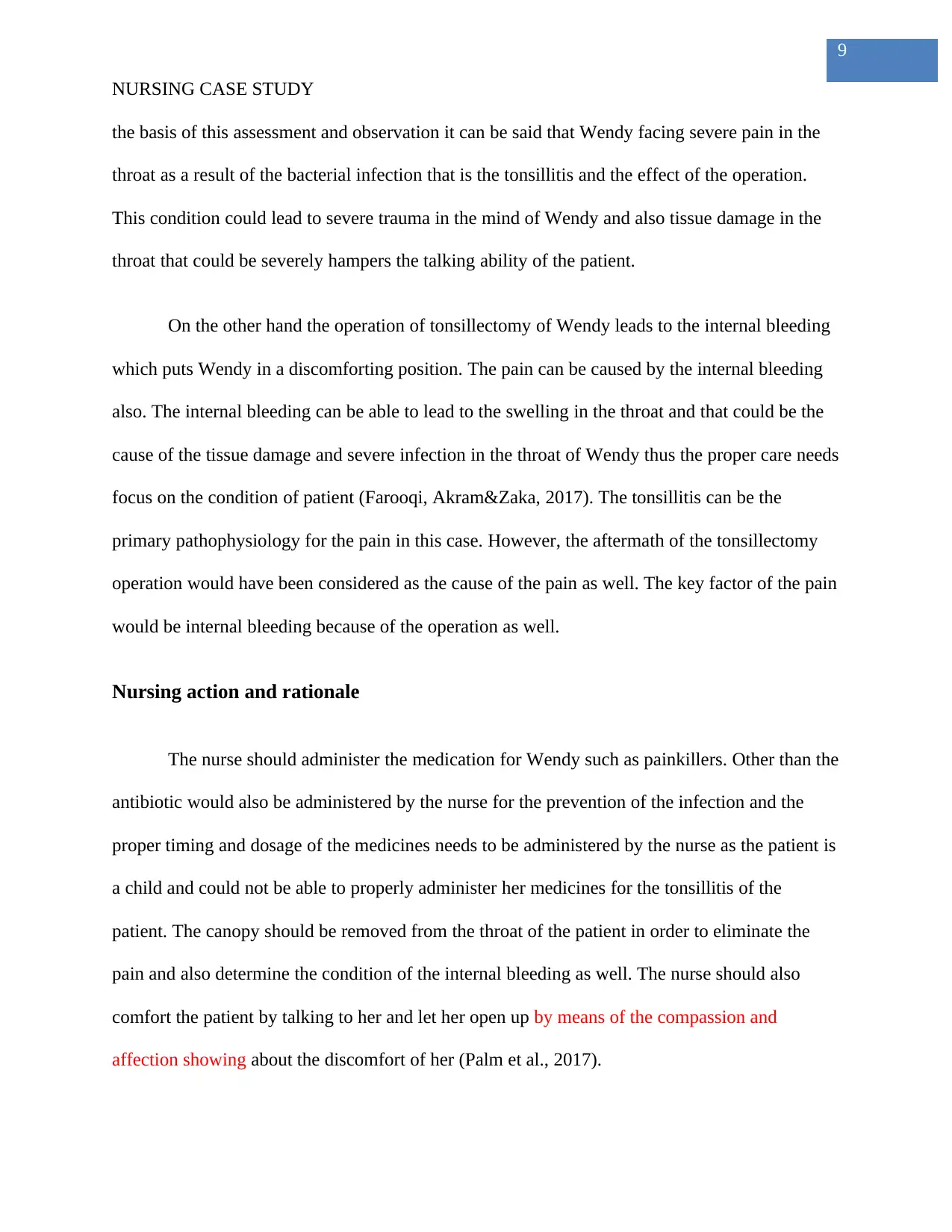
9
NURSING CASE STUDY
the basis of this assessment and observation it can be said that Wendy facing severe pain in the
throat as a result of the bacterial infection that is the tonsillitis and the effect of the operation.
This condition could lead to severe trauma in the mind of Wendy and also tissue damage in the
throat that could be severely hampers the talking ability of the patient.
On the other hand the operation of tonsillectomy of Wendy leads to the internal bleeding
which puts Wendy in a discomforting position. The pain can be caused by the internal bleeding
also. The internal bleeding can be able to lead to the swelling in the throat and that could be the
cause of the tissue damage and severe infection in the throat of Wendy thus the proper care needs
focus on the condition of patient (Farooqi, Akram&Zaka, 2017). The tonsillitis can be the
primary pathophysiology for the pain in this case. However, the aftermath of the tonsillectomy
operation would have been considered as the cause of the pain as well. The key factor of the pain
would be internal bleeding because of the operation as well.
Nursing action and rationale
The nurse should administer the medication for Wendy such as painkillers. Other than the
antibiotic would also be administered by the nurse for the prevention of the infection and the
proper timing and dosage of the medicines needs to be administered by the nurse as the patient is
a child and could not be able to properly administer her medicines for the tonsillitis of the
patient. The canopy should be removed from the throat of the patient in order to eliminate the
pain and also determine the condition of the internal bleeding as well. The nurse should also
comfort the patient by talking to her and let her open up by means of the compassion and
affection showing about the discomfort of her (Palm et al., 2017).
NURSING CASE STUDY
the basis of this assessment and observation it can be said that Wendy facing severe pain in the
throat as a result of the bacterial infection that is the tonsillitis and the effect of the operation.
This condition could lead to severe trauma in the mind of Wendy and also tissue damage in the
throat that could be severely hampers the talking ability of the patient.
On the other hand the operation of tonsillectomy of Wendy leads to the internal bleeding
which puts Wendy in a discomforting position. The pain can be caused by the internal bleeding
also. The internal bleeding can be able to lead to the swelling in the throat and that could be the
cause of the tissue damage and severe infection in the throat of Wendy thus the proper care needs
focus on the condition of patient (Farooqi, Akram&Zaka, 2017). The tonsillitis can be the
primary pathophysiology for the pain in this case. However, the aftermath of the tonsillectomy
operation would have been considered as the cause of the pain as well. The key factor of the pain
would be internal bleeding because of the operation as well.
Nursing action and rationale
The nurse should administer the medication for Wendy such as painkillers. Other than the
antibiotic would also be administered by the nurse for the prevention of the infection and the
proper timing and dosage of the medicines needs to be administered by the nurse as the patient is
a child and could not be able to properly administer her medicines for the tonsillitis of the
patient. The canopy should be removed from the throat of the patient in order to eliminate the
pain and also determine the condition of the internal bleeding as well. The nurse should also
comfort the patient by talking to her and let her open up by means of the compassion and
affection showing about the discomfort of her (Palm et al., 2017).
Paraphrase This Document
Need a fresh take? Get an instant paraphrase of this document with our AI Paraphraser
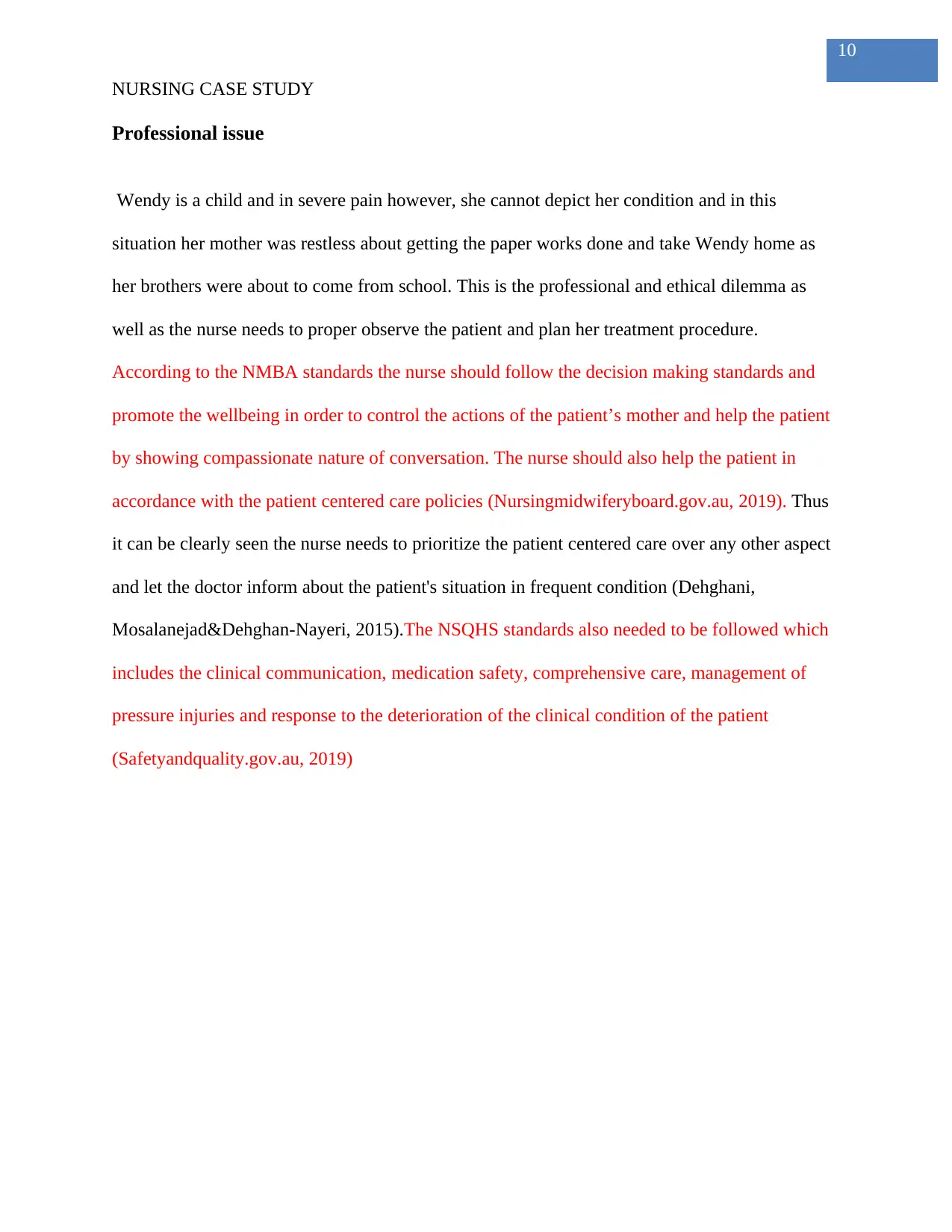
10
NURSING CASE STUDY
Professional issue
Wendy is a child and in severe pain however, she cannot depict her condition and in this
situation her mother was restless about getting the paper works done and take Wendy home as
her brothers were about to come from school. This is the professional and ethical dilemma as
well as the nurse needs to proper observe the patient and plan her treatment procedure.
According to the NMBA standards the nurse should follow the decision making standards and
promote the wellbeing in order to control the actions of the patient’s mother and help the patient
by showing compassionate nature of conversation. The nurse should also help the patient in
accordance with the patient centered care policies (Nursingmidwiferyboard.gov.au, 2019). Thus
it can be clearly seen the nurse needs to prioritize the patient centered care over any other aspect
and let the doctor inform about the patient's situation in frequent condition (Dehghani,
Mosalanejad&Dehghan-Nayeri, 2015).The NSQHS standards also needed to be followed which
includes the clinical communication, medication safety, comprehensive care, management of
pressure injuries and response to the deterioration of the clinical condition of the patient
(Safetyandquality.gov.au, 2019)
NURSING CASE STUDY
Professional issue
Wendy is a child and in severe pain however, she cannot depict her condition and in this
situation her mother was restless about getting the paper works done and take Wendy home as
her brothers were about to come from school. This is the professional and ethical dilemma as
well as the nurse needs to proper observe the patient and plan her treatment procedure.
According to the NMBA standards the nurse should follow the decision making standards and
promote the wellbeing in order to control the actions of the patient’s mother and help the patient
by showing compassionate nature of conversation. The nurse should also help the patient in
accordance with the patient centered care policies (Nursingmidwiferyboard.gov.au, 2019). Thus
it can be clearly seen the nurse needs to prioritize the patient centered care over any other aspect
and let the doctor inform about the patient's situation in frequent condition (Dehghani,
Mosalanejad&Dehghan-Nayeri, 2015).The NSQHS standards also needed to be followed which
includes the clinical communication, medication safety, comprehensive care, management of
pressure injuries and response to the deterioration of the clinical condition of the patient
(Safetyandquality.gov.au, 2019)
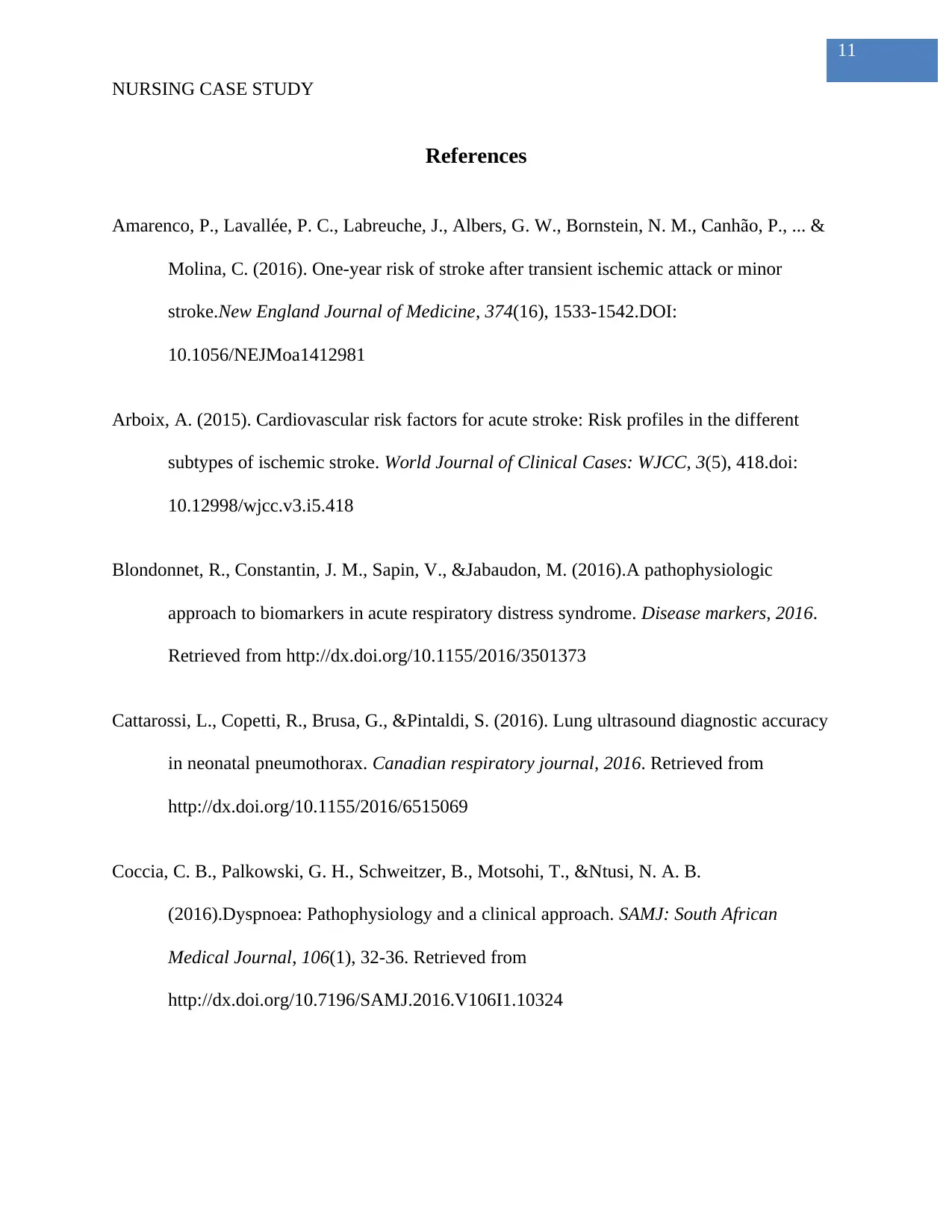
11
NURSING CASE STUDY
References
Amarenco, P., Lavallée, P. C., Labreuche, J., Albers, G. W., Bornstein, N. M., Canhão, P., ... &
Molina, C. (2016). One-year risk of stroke after transient ischemic attack or minor
stroke.New England Journal of Medicine, 374(16), 1533-1542.DOI:
10.1056/NEJMoa1412981
Arboix, A. (2015). Cardiovascular risk factors for acute stroke: Risk profiles in the different
subtypes of ischemic stroke. World Journal of Clinical Cases: WJCC, 3(5), 418.doi:
10.12998/wjcc.v3.i5.418
Blondonnet, R., Constantin, J. M., Sapin, V., &Jabaudon, M. (2016).A pathophysiologic
approach to biomarkers in acute respiratory distress syndrome. Disease markers, 2016.
Retrieved from http://dx.doi.org/10.1155/2016/3501373
Cattarossi, L., Copetti, R., Brusa, G., &Pintaldi, S. (2016). Lung ultrasound diagnostic accuracy
in neonatal pneumothorax. Canadian respiratory journal, 2016. Retrieved from
http://dx.doi.org/10.1155/2016/6515069
Coccia, C. B., Palkowski, G. H., Schweitzer, B., Motsohi, T., &Ntusi, N. A. B.
(2016).Dyspnoea: Pathophysiology and a clinical approach. SAMJ: South African
Medical Journal, 106(1), 32-36. Retrieved from
http://dx.doi.org/10.7196/SAMJ.2016.V106I1.10324
NURSING CASE STUDY
References
Amarenco, P., Lavallée, P. C., Labreuche, J., Albers, G. W., Bornstein, N. M., Canhão, P., ... &
Molina, C. (2016). One-year risk of stroke after transient ischemic attack or minor
stroke.New England Journal of Medicine, 374(16), 1533-1542.DOI:
10.1056/NEJMoa1412981
Arboix, A. (2015). Cardiovascular risk factors for acute stroke: Risk profiles in the different
subtypes of ischemic stroke. World Journal of Clinical Cases: WJCC, 3(5), 418.doi:
10.12998/wjcc.v3.i5.418
Blondonnet, R., Constantin, J. M., Sapin, V., &Jabaudon, M. (2016).A pathophysiologic
approach to biomarkers in acute respiratory distress syndrome. Disease markers, 2016.
Retrieved from http://dx.doi.org/10.1155/2016/3501373
Cattarossi, L., Copetti, R., Brusa, G., &Pintaldi, S. (2016). Lung ultrasound diagnostic accuracy
in neonatal pneumothorax. Canadian respiratory journal, 2016. Retrieved from
http://dx.doi.org/10.1155/2016/6515069
Coccia, C. B., Palkowski, G. H., Schweitzer, B., Motsohi, T., &Ntusi, N. A. B.
(2016).Dyspnoea: Pathophysiology and a clinical approach. SAMJ: South African
Medical Journal, 106(1), 32-36. Retrieved from
http://dx.doi.org/10.7196/SAMJ.2016.V106I1.10324
⊘ This is a preview!⊘
Do you want full access?
Subscribe today to unlock all pages.

Trusted by 1+ million students worldwide
1 out of 16
Related Documents
Your All-in-One AI-Powered Toolkit for Academic Success.
+13062052269
info@desklib.com
Available 24*7 on WhatsApp / Email
![[object Object]](/_next/static/media/star-bottom.7253800d.svg)
Unlock your academic potential
Copyright © 2020–2025 A2Z Services. All Rights Reserved. Developed and managed by ZUCOL.





